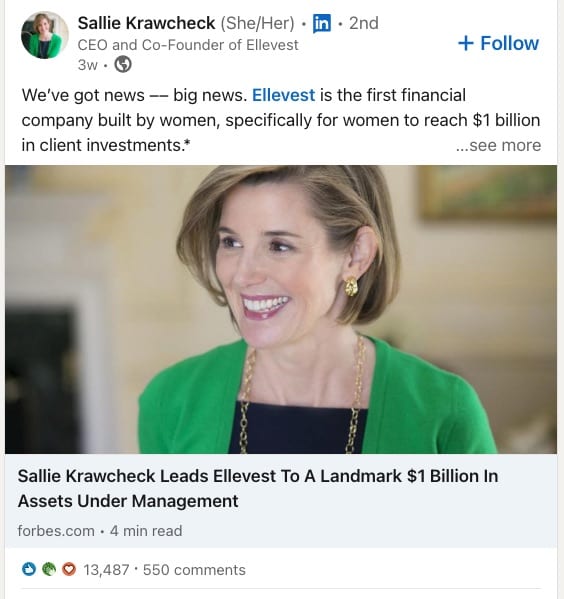Have you ever wondered how people come to be known as thought leaders? And whether or not thought leaders are also influencers? Influencer marketing has hit the mainstream with the use of social media sites as marketing tools. This has led to the term “thought leadership” being used to describe practically anyone from celebrity influencer to “opinion leaders.” The term is often oversimplified and misunderstood, which is why, in this guide to thought leadership, we’re going to nail down precisely what thought leadership is and its intersection with influencer marketing.
In this article, we discuss:
- What thought leadership is
- How it relates to influencer marketing
- How to become a thought leader in your niche and use it for marketing your business or clients
 What is Thought Leadership?
What is Thought Leadership?
Just as thought leadership relies on reputable sources, we’ll start with one to describe what thought leaders are. Skye Schooley, a staff writer for Business News Daily, describes a thought leader as,
“Someone who, based on their expertise and perspective in an industry, offers unique guidance, inspires motivation, and influences others.”
In other words, thought leaders become who they are and gain their following based on their experience in an industry, how they express that knowledge, and the actions they take to encourage their friends, followers, and fans to take similar steps. In this way, a thought leader’s passion for a brand or cause can become actionable change. This gives their reputation, actions, and thoughts power over their audiences and fans.
Who Can Become a Thought Leader?
Knowing the potential power of thought leadership, let’s talk about how someone becomes a thought leader in the first place. The first thing to understand about this is that being knowledgeable is not enough. There’s no thought leader without a thought leadership strategy to express knowledge in public forums, such as blogs, social media posts, podcasts, speaking engagements, and…. And an expert is not a thought leader without gaining followers. This means that you need to make the right moves to convince others to consider you a thought leader.
Firstly, you need to know your niche, industry, or subject. As you begin to expand and express your knowledge, expertise, and experience in this niche, you need to keep an eye on your industry’s fast-changing aspects. To stay on the cutting edge without losing your balance, you must keep absorbing and using new information about your subject.
This requires a certain kind of leadership personality, which is why for some, it may not come naturally to pursue being thought leaders and profit from it. You have to seek new information with passion, persevere through the things you don’t know, and fight to change your niche by “out-teaching the competition” (something that I borrowed from Jason Fried). This is why starting with expertise in a field gives you a head-start on becoming a thought leader. If you already own a business or brand, you may already have a following that you can grow and use.
Here’s one example of how to jump from being an expert to being a thought leader. Consider the situation of the motivational speaker. They don’t necessarily have a “product.” They give speeches and seminars, talking about how they succeeded in life (and didn’t). These speeches alone can’t make the speaker a thought leader, but they grant him/her the perspective that people will learn from.
Now, if the speaker can respond to trends in their industry and grow their following, their speeches become more than a single product. They motivate others to consider the speaker a leader in their industry. Their thoughts have become influential in terms of products and services related to the niche in which they are now perceived as an authority.
This brings us to influencer marketing and how it relates to all this.
How Thought Leaders Become Influence Marketers
Remember that creating thought leadership requires both “thought” – the expertise that you have in your industry – as well as “leadership.” And it’s this combination the exerts influence.
Individuals and companies alike can use an expert’s point of view to elevate their brands. But thought leadership goes beyond just experience. It requires connecting the leader to the needs of their followers. Even in the case of a consumer company connecting to their consumers, plus their expert perspective can make influencer marketing a far more viable strategy.
Consider the example of the fashion blogger. This person may be an industry expert, or they may simply have the expertise generated from running their blog for a while. Either way, they have gained the power to influence their followers’ purchasing decisions based on this authority. And if they stay up on trends in their industry while striving to remain authentic (rather than automated), they may be able to grow their followership and influence on their followers even more.
Now that this reputation as a thought leader or trendsetter has been established, influencer marketing should come naturally. Whether for a company or their own brand, their thought leadership now validates their credentials as an influence marketer. It is important to find effective strategies to avoid bad influencer marketing.
Strategies for Success in Influencer and Thought Leadership Marketing
We don’t want to leave terms like “expertise” and “leadership” in the abstract. Here is a practical breakdown of how to go from being a thought leader to an influencer.
- Organize your expertise and around your unique perspective. Dare to express a unique point of view. This means creating a plan for your position in your industry and how you will use it to generate buzz around your experience.
- Establish followership using tools appropriate for your niche. Fashion favors Instagram while motivational speaking favors YouTube on LinkedIn, for instance. Work within your industry.
- Grow your followership by creating regular, personal content for your niche. People have so many options now that they can be turned off by what they perceive as automated or copy/paste marketing. Add your personal experience to everything you post.
- Be authentic by speaking from personal experience, sharing ideas, asking for feedback and participation, and participating by commenting on other’s content. We made a few videos about the role of authenticity in thought leadership.
- Being hired as an influencer or becoming one on your own terms can only happen once you’ve generated enough thought leadership. Those compelled by your decisions will eventually make it possible for you to exert influence, not merely knowledge.
Examples of Great Thought Leadership
Grow by Acorns: Acorns not only has a very friendly and engaging welcome email series, but they developed Grow, a website with easy-to-understand, straightforward, and people-focused investment and personal finance advice.

Autodesk’s Redshift: The editorial team of the software company applied a forward-looking content strategy that focuses on what’s at the forefront of architecture, construction, infrastructure, manufacturing technology, and sustainability. It’s important to note that they go beyond their core services. They expand the discussion topics with a focus on the future in multiple areas and industries. This is the difference between those who express thought leadership and those who just do content marketing – daring to go beyond the core features of the product or service you are selling.
Several members of the Autodesk senior executive team are authors of their own series on Redshift, such as the “Inside My Design Mind” series. According to the Marketing Insider Group, “By securing buy-in from the executive team as influential “content marketing champions”, the content team has successfully implemented an employee advocacy program and is reaping the rewards from this approach.”
Autodesk are bold and admirable in their approach.

Sallie Krawcheck, CEO and co-founder, Ellevest: According to Sallie, “I typically write about what I’m going through and topics I’m thinking through.” She has over 2.6MM followers on LinkedIn and her approach is unique and bold. A small percentage of company executives dedicate this much time to content development and engagement on LinkedIn. I advise every executive team to follow Sallie’s example. It is incredibly powerful at elevating a company’s brand and will get much more traction than simply posting to a corporate social media account.
Takeaways from this Guide to Thought Leadership and Influence
Thought leadership is neither a quick fix for increasing your marketing potential nor an automatic path to becoming an influencer. Thought leadership marketing simply represents the expression of expertise, experience, and point of view on which influence can be built.
Profitable marketing in the 21st century relies on the user experience, which is why companies seek out users with influence, especially those who have risen to thought leaders status, to change trends in their favor. This translates an expert’s perspective directly into a return on investment. And that’s what makes it so powerful.


Leave a Reply